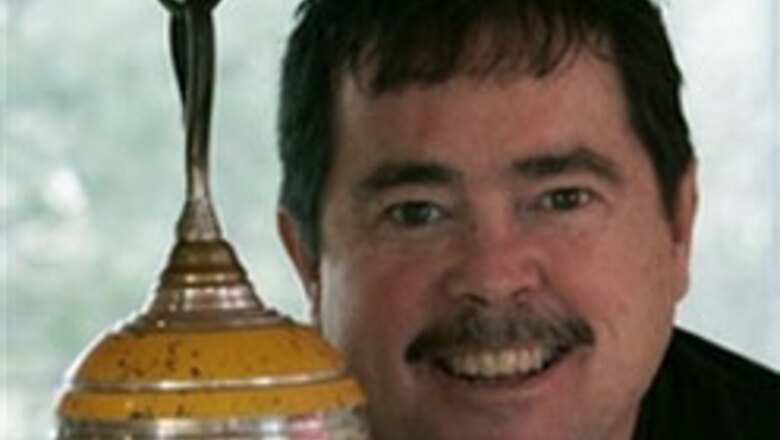
views
Brunswick (Maine): Thousands of adventurers have been drawn to Mount Everest by the challenge of climbing to the top of the world. Jeff Clapp was drawn by the trash they leave behind.
Inspired by a documentary about Everest's rubbish, Clapp traveled to Nepal and brought a load of discarded oxygen bottles back in 2004.
He has created a business of transforming those banged-up, aluminum containers into gleaming bells, bowls and ornaments with a goal of inspiring people to do more to clean up the environment in their own small ways, just as he has.
"One guy can make a difference," he said, whether by transforming trash into treasures, turning off lights, installing insulation or using less gas.
What began as a "madcap idea" is now called Bells from Everest. Clapp has sold 35 bells and bowls so far.
The trashing of Everest began even before Sir Edmund Hillary and Sherpa Tenzing Norgay first scaled the world's tallest mountain in 1953. Hillary acknowledged leaving behind oxygen bottles, food containers and torn tents in a pile near his base camp.
Like Hillary, virtually all hikers rely on oxygen because the air at Everest's summit has only one-third of the oxygen found at sea level.
Over the years, hundreds of bottles piled up along with discarded climbing gear and other trash.
Rick Wilcox, of Eaton in Hew Hampshire, saw 500 to 600 bottles en route to the summit in 1991. It was common practice for climbers to dump gear to save weight on the way down.
"When it becomes your life or your gear, you choose your life and leave the gear behind," he said.
Thing have changed in recent years. Efforts to clean up the 29,035-foot mountain include a successful bounty program for oxygen bottles left behind.
The Nepalese government now requires expeditions to pay deposits that are forfeited if rubbish is left behind.
By doing this, fresh garbage is reduced and the cumulative problem is controlled, Deebas Bickram Shah of the Nepal Mountaineering Association said in an e-mail.
John Bagnulo, who became the first Mainer to reach Everest's summit on his 36th birthday last May 11, said he was heartened by what he saw on the less-traveled north side.
"I didn't see that many empty oxygen bottles, so that's a good thing," Bagnulo said by telephone from Massachusetts, where he now works at a wellness center in the Berkshires. "I was pleasantly surprised by the low volume of trash,” he added.
Clapp, an artist, chef and concerned father, was inspired to go to Nepal by a
National Geographic documentary about trash on Everest, which some called "the world's highest junkyard."
He obtained 132 cylinders from the Nepal Mountaineering Association for $7,000. It cost nearly that much to ship them back to Maine.
Back at home in Brunswick, he works on the canisters in a basement workshop where the floor is littered with piles of aluminum shavings.
The hardest part, he said, is stripping away the yellow fiberglass shell to expose the darkened, oxidised aluminum underneath. He then uses hand tools to shape the bottles as they spin on a wood-turning lathe.
Eventually, they're buffed to a shiny silver color. Prices range from $1,600 to $3,000 for bells, and $500 to $1,500 for the bowls.
Little goes to waste. The shavings are put in glass balls to become $15 Christmas ornaments that Clapp originally created as gifts for family members.
They're sold at several locations, including the gift shop at Walt Disney World's Expedition Everest roller coaster, he said.
The work takes time, especially for the more expensive items. In December, he sold six pieces in one five-day period, which he described as a flood of orders.
Forty-eight year old Clapp said buyers like getting a unique piece of artwork and knowing that they're helping the environment at the same time.
"They see the added value of purchasing a gift item that has social responsibility," he added.
When his supply of oxygen cylinders runs out, Clapp doesn't plan to retrieve any more of them. By the time he uses them up in a few years, he'd like to return to Nepal to show locals how to create the bells to make money for themselves.
Clapp has had a preliminary discussion with a Bates College graduate who founded Porters' Progress, a Sanbornton, New Hampshire-based organisation that works to improve the lives of the porters who carry equipment for Everest expeditions.
Ben Ayers from Porters' Progress said there are challenges including startup costs but he likes Clapp's idea of teaching metalsmithing skills to poor children. It's "just crazy enough to work," he wrote in an e-mail from Katmandu.
Clapp said he hopes to line up corporate sponsors for the project, and to create a documentary. Eventually, he wants to write a book.
"My ultimate goal of returning this project to Nepal is very exciting to me," he said. "When I first visualised creating this artwork, I was driven with the concept that it would be a benefit to others, specifically in Nepal,” he added.




















Comments
0 comment